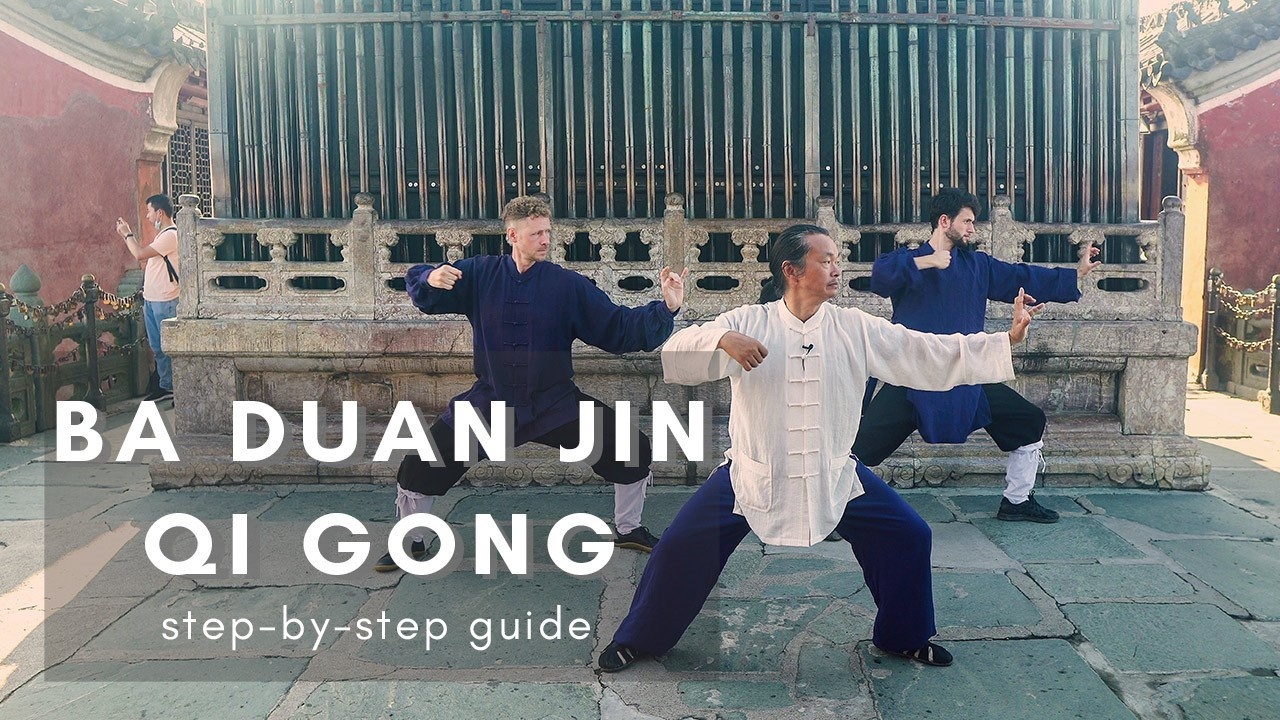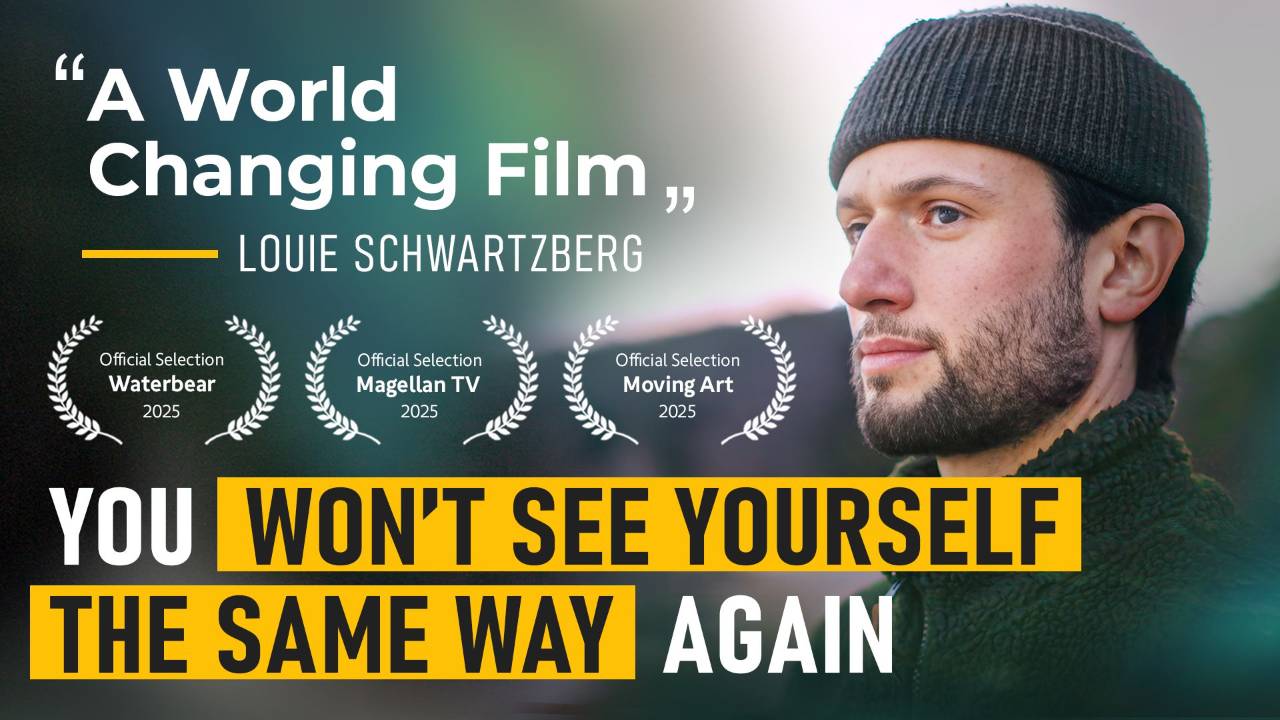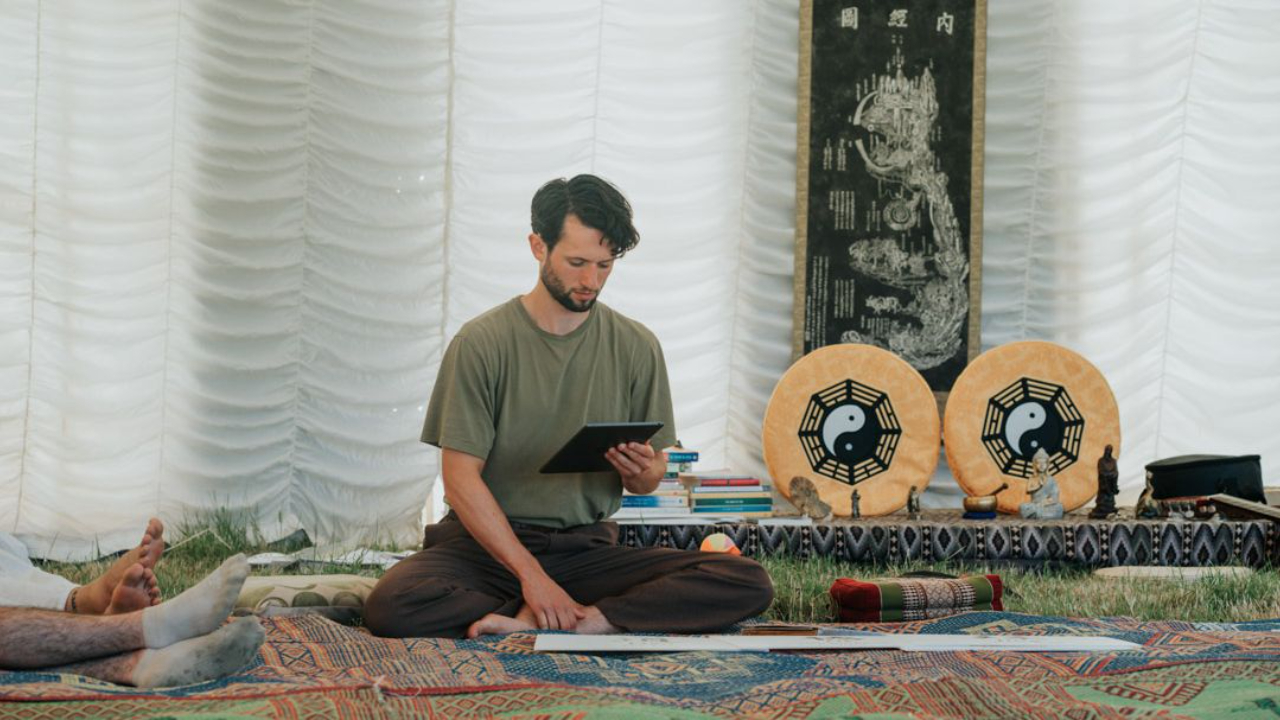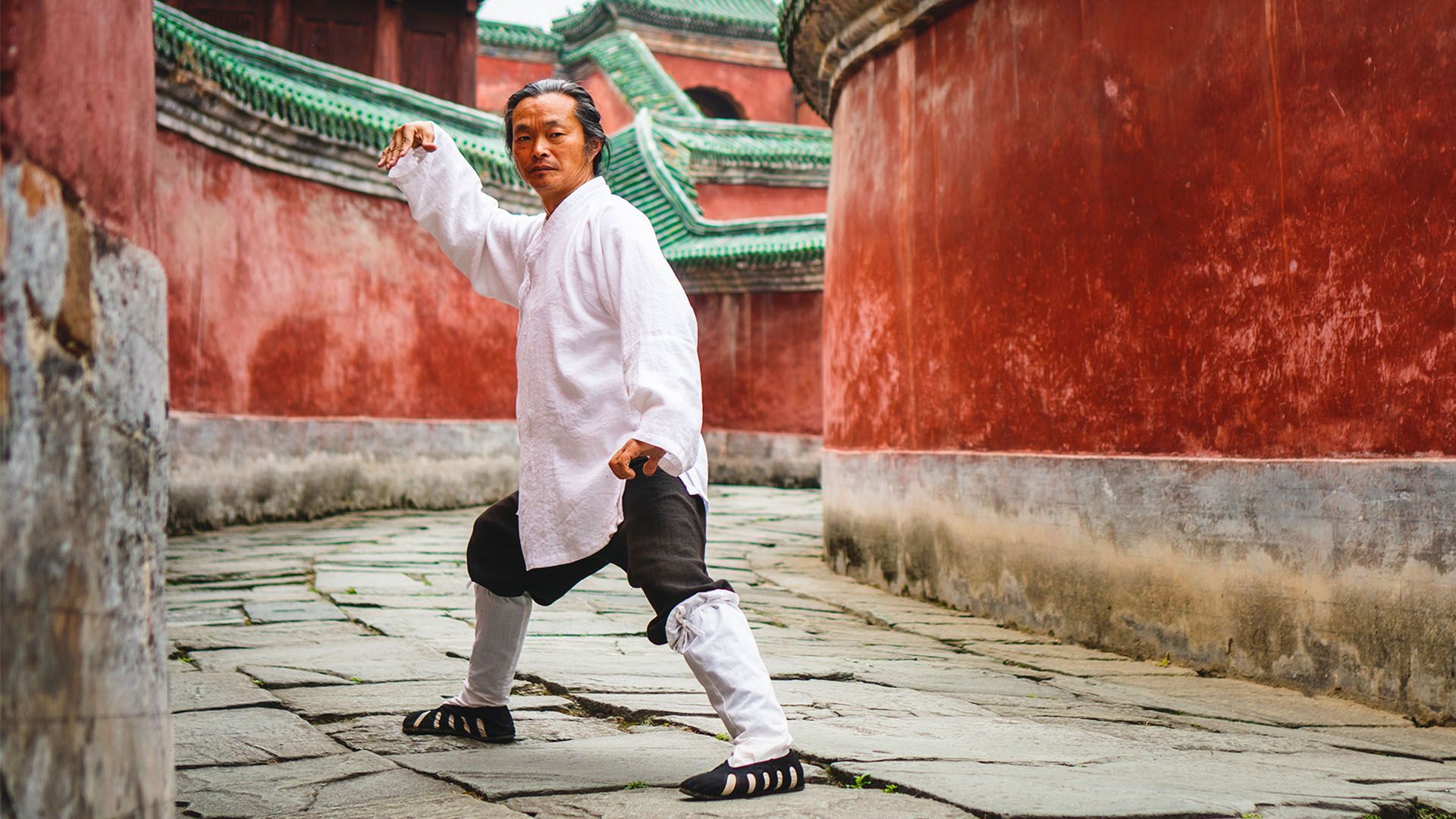Ba Duan Jin Qi Gong: In-Depth Guide And Qigong Exercises
Oct 07, 2024
During my tuition at the Wudang Taoist Wellness Academy, Master Gu taught me not only multiple forms of Tai Chi but also various other Qi Gong forms.
Each had a name that was even more evocative and enchanting than the previous.
Five Animal Frolics Qi Gong.
Six Sound Healing Qi Gong.
And Eight Pieces of Brocade Qi Gong. But we call it by its Chinese name: 八段錦 bāduànjǐn, or Ba Duan Jin.
In this post, I’d like to offer a brief introduction to this perhaps most well-known of the Qi Gong forms: Eight Brocade Qi Qong.
Eight Segments of Brocade
八bā means ‘eight’. 段 duàn means ‘segment’ or ‘part’, ‘piece’. 錦jǐn means ‘brocade’. I had to look it up.
‘A rich fabric woven with a raised pattern, typically with gold or silver thread,’ the dictionary informed me. Here’s a picture.

Chinese black-and-silver brocade: here, too, be dragons! (source: www.etsy.com)
Some interpretations have it that the name is a play on words, the original meaning being ‘mend broken sinews’; others suggest that the exercises are designed in such a way as to make the body and its energy (qì) smooth as silk—hence the name 8 pieces of brocade.
Different sources offer different origin stories, too. Was it created in the Song dynasty (960-1279 CE)? Or does it know an even older conception by Lu Dongbin, who was born in 796 in the Tang dynasty and allegedly lived for over two centuries? Some claim it was first taught by a Taoist to none other than Chong Li-Quan, one of the Eight Immortals! It is hard to be certain.
And perhaps none of this is important.
For you, for me, and for us as Qi Gong practitioners, what matters is the movements and their health-giving, life-enriching effects. There are many variations of Eight Brocade Qi Gong in circulation; there is no ‘one right one’—this is Taoism, after all—but rest assured that any variant taught by an experienced master or instructor will benefit you immensely.
Ba Duan Jin video with Master Gu (WTWA)
This is the Ba Duan Jin as Master Gu Shining of the Wudang Taoist Wellness Academy has been teaching it for many years. The one that makes me feel more alive every single time I practice it.
Before we do, please be advised that the following description is an offering to help you understand the form better. I also recommend learning with video tuition and a Qi Gong instructor (if possible). Take things easy and listen to your body, stop if you're feeling pain or discomfort.
So let’s dive in.
An eight-phrase instruction manual
What the Qi Gong masters generally agree on is that Ba Duan Jin has been handed down through the centuries as eight short, simple sentences. Let’s go through them one by one
0. 预备yù bèi shì
Preparatory form
This you will find in virtually every Qi Gong form: prepare for the form itself. How?
Step left, shoulder width, bend the knees slightly, sink down a little, and ground yourself. The hands are in front of the lower dāntián (just below the navel), and your palms face your belly. Your body is relaxed and straight in a natural way; your breathing happens as it does, naturally again; your mind grows peaceful; and your face relaxes, too.
Now you are ready.
1. 两手托天理三焦 liǎng shǒu tuō tiān lǐ sān jiāo
Two hands support the sky to adjust the Triple Warmers
The hands move from low to high, with fingers intertwining to form a strong support for the heavens. You inhale on the up, hold for a moment, then exhale on the down. You perform round, circular, and soft movements. Despite their appearance, these movements involve a lot of stretching. Joints open up, muscles become supple, and the spine and rib cage also receive attention. Deep, calm breaths benefit the lungs.
The focus primarily lies on the Triple Warmers or Three Heaters. In Traditional Chinese Medicine (TCM), these refer to the three body areas connected to heat generation and food digestion. However, a closer examination reveals that the sān jiāo plays a crucial role in applying qì to numerous other organs. 'Other' refers to the fact that the Triple Warmers serve as the sixth organ, with the liver, spleen, heart, kidneys, and lungs comprising the five 'solid' organs.
Of course, the body contains more organs, like the intestines, bladder, and stomach. These 'hollow' organs allow for the passage of various bodily substances. However, the Triple Warmers, unique in their category, consist of three chambers or spaces that regulate and influence the functions of various internal organs. The Triple Warmers facilitate the dispersal of fluids, the digestion of food, and the absorption of vital nutrients.
This first exercise, the first piece of brocade, therefore starts us off with thoroughness. We are cleaning the three rooms that are instrumental in promoting our overall health, life energy, and longevity from the inside.
By the way, we repeat each exercise about eight times, unless otherwise prescribed.
2. 左右开弓似射雕 zuǒyòu kāigōng sì shè diāo
Draw the bow to shoot eagles to left and right
This movement mimics the drawing of a bowstring, then releasing it. First with one hand, then with the other. It has us sink deep into our hips, opening the pelvis, and bringing the lower dāntián closer to the ground. Knees, calves, thighs, hip joints: they all get a proper work-out. Meanwhile, the torso remains upright and soft, turning left and right, opening the arms and thereby the chest, giving space to the lungs. The breathing is slightly more complex for this one, as we manage two inhalations and two exhalations on each side before changing sides. Once you get into the rhythm, your breathing will follow the movement with a sense of deep contentment.
3. 调理脾胃臂单举 tiáoli píwèi bì dānjǔ
Raise hand on each side to take care of spleen and stomach
This action focuses on the spleen (脾 pí)and the stomach (胃wèi. It is a long, diagonal stretch, alternating between the left and right sides of the body. One arm reaches up, the other goes low; then changes. The position of the hands is important here: the upper palm facing the sky, the lower one facing the ground. We absorb the qì from both 天 tiān, heaven, and 地 dì, earth. Peaceful, deep breathing at once supports and is supported by this powerful stretch. This gives space and a kind of internal massage, too, to the spleen and stomach. In the change, the hands cross in an aesthetically pleasing fashion. Peaceful, powerful, and beautiful Qi Gong!
4. 五劳七伤往后瞧 wǔ láo qī shāng wǎng hòu qiáo
To look back from left and right
“To relieve the problem of exceeding use of your emotions,” as Master Gu explains this exercise. This is perhaps the easiest, gentlest, and smallest of the eight pieces of brocade. It is a calming, centering action, which I always find takes me out of any possible narrow focus and helps me realize once again that there is a whole world around me.
The head turns gently from side to side, to the point where you can and indeed do look over your shoulder, left, then right: 180+-degree vision. The arms accompany this slow, sweeping glance with another opening-up movement as if to say, “I am open to the universe as it presents itself to me.” The shoulders roll, the joints unlock, and they unfurl. Be careful not to overstretch them: keep the elbows near the front of the torso and let the hands make a subtle waving motion, again without over-flexing the wrist. Soft lines, supple limbs.
5. 摇头摆尾去心火 yáo tóu bǎi wěi qù xīn huǒ
To shake the head and tail to relieve you from heart-fire
Who wouldn’t want that? The prospect of shaking the head and tail alone is enough to get me going! To relieve you from heart-fire, 心火xīn huǒ: indeed, I like to imagine I am blowing out a row of candles in this exercise. Or, to be honest, I imagine I am a firefighter helicopter dumping a massive bucket of water on a forest fire. Sometimes I am a conjurer from whose lips emanate a fire-extinguishing magical spirit. Did I mention this is an enchanting Qi Gong form?
Meanwhile, do not underestimate the physical work you need to do for this ‘shaking the head and tail’! A wide horse stance is required: squat much? Master Gu kindly teaches an interpretation of this fifth phrase that allows a brief respite when coming up on either end, but there are masters who insist the wide stance is never abandoned throughout. Hands on hips, thumbs point to the back, you sink, and sink some more. Inhale, and your torso bends forward, parallel to the ground.
On the exhale, you make a big semi-circle with your upper body, putting out that heart-fire. Bending, unbending, squatting, rotating: this is serious gym stuff, my friends! But soft and supple, peaceful and beautiful. Work out; don’t get worked up now—the point is after all to reduce that heart-fire…
6. 两手攀足固肾腰 Liǎng shǒu pān zú gù shèn yāo
To grab your two feet to strengthen the kidneys and waist
Yes, this sixth movement emphasizes the kidneys, which are given room by bending all the way down in a slow, gentle arc until your body is basically doubled over. A Tai Chi master like Master Gu is so flexible that he can stand like that, grasping his feet with ease. For the less limber among us, it is fine to grab our shins, ankles, wherever you naturally end up when you bend forward without overstretching.
Keep the legs straight without locking the knees. Your hamstrings will feel this piece of brocade, too, as will your waist and lower back. Then we stand for a spell. Focus your attention on your kidneys, which right now are suddenly experiencing more space as well as gravity. They can relax, expand, and enjoy the massage of the back muscles.
Wobble gently from left to right to increase the effectiveness of this massage. Enjoy the view of the ground. Is that a little caterpillar in front of your feet there? Look at that little creature! Look at it go!
Then it is time to come up calmly. The hands make a kind of scooping motion forward, then they turn up high to have the fingertips face each other before softly pressing down. When they reach the top of the chest, the thumbs trace a line around the armpits to the back, where the heel of the hand starts a gently firm downward massaging rub, as if pushing the whole torso into the doubling-over, bending shape again. When your hands connect with your kidneys, be aware of that with loving attention. Then it’s time to grab the shins/ankles/feet again. Such self-care! Enjoy!

7. 攒拳怒目增气力 zǎn quán nù mù zēng qì lì
Clench the fists and glare angrily to increase the qì
Have we been transported to Japan? Is this karate all of a sudden? Cross-pollination, perhaps! The fiercest exercise of Eight Brocade Qi Gong, this action takes us into a semi-wide horse stance. Our hands form (hollow!) fists by our sides, elbows bent, thumbs curled around the index and middle fingers, and facing up. A punch with a twist of the wrist ensues; the force comes from the waist/pelvis, which twists forward on the side of the punch (left first). At the same time, your breath is let out with a grunt: qí burst! Next, the hand makes a grabbing motion with a rotation of the wrist that is hard to describe in words. It pulls back as the other hand repeats the movement.
And again, and again. Remember to make that angry glare at an imaginary adversary! Feel the energy course up from your lower dāntián and shoot out at the point where your punching fist would connect with that adversary’s torso. See them buckle! See them fall! Repeat four times on both sides, or to your contentment, if you have some extra steam to blow off.
8. 背后七颠百病消 bèi hòu qī diān bǎi bìng xiāo
Bounce seven times to make diseases disappear
What a fun piece of brocade to finish with! Hands on hips, feet loosely together, jump and bounce, bounce. Jump, bounce, bounce. Everything is bounced into place, while the cheerfulness of Tigger bubbles up all through your body. By doing this, literally “all kinds of diseases and ailments” disappear? Who knew it was this simple and so much fun!
9. 收式 shōu shì
Closing form
Step in with the left foot to the right, slightly sunk. At the same time, the hands make a circle from down to up to down again. When the feet meet, rise up (unsink) and let the hands come together on the lower dāntián. Breathe. Finish. Return.
Done!
A great way to start a work-out
Whether you are about to do a Tai Chi practice session or any other kind of work-out, Ba Duan Jin Qi Gong will get your blood and qí flowing. It will warm all your muscles and make them flexible. Then go on that run, or practice 33 Form, or have a swim. It is a great way to start the day, too. Morning exercise like no other!
Similarly, a fine way to end a Tai Chi practice routine, especially in the afternoon, if you feel that you need some yang to keep going. It’s a great way to feel alive again in the evening, too, if you’ve been stationary for a long time, enjoying some recumbent couch-potato downtime. Or been quashed in a game of Chinese chess by your master… ahem.
In short, any time of day is a good time for Eight Brocade Qi Gong. I simply know that now that you’ve read about it, you cannot wait to get started!
Baduanjin Exercises for Regulating Internal Organs
Baduanjin, or Ba Duan Jin, a form of Qigong exercise, is deeply rooted in Traditional Chinese Medicine. These exercises, known as "Eight Pieces of Brocade" or "Eight-Section Brocade," are renowned for regulating the body's meridians. By harmonizing qi, Ba Duan Jin specifically targets organs like the kidney and spleen. This ancient practice, akin to Tai Chi, consists of eight movements designed to stimulate and improve internal health. Among its most common benefits, Baduanjin strengthens the kidneys and supports the spleen and stomach. It's considered a holistic healer, comparable to the triple heater concept in Chinese medicine, fostering overall well-being and organ balance. One of the most common traditional Chinese exercises is renowned for its ability to improve health through simple movements. These exercises focus on regulating internal organs, offering a holistic approach to wellness and vitality.
It is renowned for its role in improving overall health and regulating internal organs. Originating from the Song Dynasty, this exercise is a set of eight separate movements, each targeting a different physical area and Qi meridian. The Chinese Health Qigong Association recognizes the practice, which combines deep breathing with gentle, flowing movements. Baduanjin, or Ba Duan Jin, is easy to master and includes both standing and seated postures, making it accessible for various age groups.
Key Benefits:
- Enhances muscular strength and flexibility, fostering physical balance and coordination.
- Actively works to regulate and improve the function of various internal organs.
- Promotes increased bone strength and improvement in muscle strength.
- Aids in the improvement of circulation, helping to prevent disease.
- It calms the mind and balances the body and spirit, contributing to mental well-being.
---
Eli Roovers, Taoist name: 丹宁资和
16th-generation Sanfeng Pai disciple and Taoist Wellness Instructor








